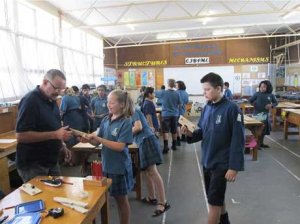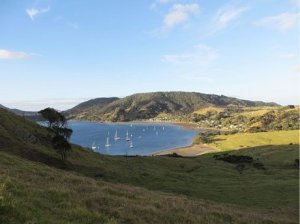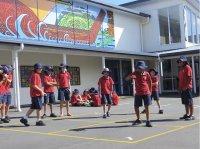“School Time” in New Zealand
Your content has been saved!
Go to My Saved Content.I've interviewed hundreds of people over the last decade about how schools in the United States often choose to structure time. Most often, I pose the question to people in the places I visit, "Can you explain how the school day is structured, and why?"
Whose Opinion Matters?
I've found that many people working within schools are usually split into two camps of thought:
- The schedule is fine just the way it is.
- We definitely could do things differently . . . but never quite get around to it.
With the majority of students and parents I interview, however, I find they fall into the second category, that the traditional concept of what the "school day" is could use an overhaul.
Of course, some amount of time is required by law in the U.S. (a.k.a. Carnegie Units). But it's flexible, often more so than we might think.
More often than not, we go faster. We add. We get busier.
School Days
I decided to travel to New Zealand (with a great bunch of people through the University of Vermont) to see all the articles I've read about school schedules there come to life. Here's how the general school day mapped out in the eight schools I visited, elementary through high school:
Start time
Class 1: 1:10
Morning tea: 20 minutes; student recess/snack, faculty "teatime"
Class 2: 1:10
Lunch: 40-50 minutes
Class 3: 1:10
Afternoon tea: Student recess/snack, faculty "teatime"
Class 4: 1:10
End of day
Once per week, school started later to accommodate a morning faculty meeting.
School departments are on a six-day rotation. Each department takes off a half or full day every six days for a professional development session. I sat in on one of those PD days with the technology teachers at the Takapuna Intermediate School. I observed as they mapped out new ideas, discussed students and the approaches they'd take collectively to offer assistance needed, and we shared many ideas on PBL, assessment, educational theory, and quite a few good stories about our craft.
Sound luxurious?
It was.
Yet I could easily see that these teachers were connected to their students, craft and each other. It's a trait I discovered at every school I visited in New Zealand.
Not Your Average Cup of Tea
Like most of the folks on the trip that were new to New Zealand schools, I wondered just what "morning tea" might look like and what its effect was on school climate and culture. Each teatime, morning and afternoon, started with folks getting something to drink in a faculty lounge. At every school, this lounge sported a small kitchen and community seating. On occasion there were announcements, but they were always given very succinctly. The majority of teatime was geared to promote collaboration and to see colleagues. Once per week, a department was in charge of putting on a feed for the collective. It was a competitive endeavor, so I learned. Very social . . . and very fun.
Think about it. If you've worked in schools, how often have you joked with colleagues about never seeing them? Perhaps you've said, "Wow, if I only knew you were doing that we could have . . . "
I interviewed many adults at these morning teas throughout the week. Every person I interviewed thought that all these collaborative times, when added up, were essential to teaching students and not just subjects. Adults felt like they had time to share concerns with peers, grow philosophically, innovate. Most importantly, when something went wrong at the school or needed to be done, the collaborative time was built in to handle it. And then they got back to innovating and discussing students.
Perhaps most importantly, every student I interviewed thought the collaborative time was essential, too. One student described the breaks as "a great time to decompress. I get time to think about what we've done. It's easier to go back to another class. I'm ready to go back to class." On a few of these teatimes, I went out to see what students were up to. I found them talking, organizing games or eating a snack. They decompressed. They relaxed. They talked to each other.
The impact on classes after these breaks during the day was also evident. Every class I saw was focused, engaged and in all instances highly participatory.
Adding It Up
Here's an outline of what that collaborative time looks like over a six-day period:
- Forty minutes per day from "teatime": 240 minutes = 4 hours
- One morning meeting per week: 30 minutes
- One half to full day of PD per six days: 5-6 hours
So in a six-day rotation, teachers and students in New Zealand have roughly ten hours of collaborative professional development time built into the schedule.
In many U.S. schools, half an hour of PD time per week would be considered luxurious.
On the time front, I also asked questions about homework. One Head of School in New Zealand said it this way:
Indeed. When's the last time you had, let's say, a 14-hour day and then sat down to learn something for fun?
I thought so.
With all these collaborative adjustments to the school day in New Zealand, academically I saw no difference in the quality or capacity of work the students do compared to what I'd consider the best schools in the U.S. I think they just did so at a much more civil pace.

What Are We Magnifying?
I've felt for many years now that how we handle time in schools magnifies many societal woes. We yearn to shift some of the things we complained about when we went to school -- and still complain about. We yearn for more collaborative planning time. We often lament, "Kids today don't have social skills," yet we have done little to rethink how we structure time and its effect on the people within schools -- and what more collaborative school initiatives could do within that new time frame.
I think that needs to change. I think that addressing how we utilize time in schools is an essential step.
The best part? Shifts in the traditional school schedule really don't require any more money. It's a cheap shift, likely costing nothing.
Cross the International Date Line to New Zealand, essentially stepping a day into the future to study time. Go figure.
It's Not a Recipe, It's a Challenge
The New Zealand model might not be a recipe for us to copy hour for hour. It's a model that works for them. They have the space at the schools to do it, the places for students to go. What their schedule does for the rest of us, hopefully, is encourage us to ask ourselves:
- What are we doing currently, and what's its impact on quality of learning and student (and family) lives?
- Does this schedule promote or hinder collaboration? For students? For adults?
- What could we do differently?
- What do we need to do?

Yes, It Is
And yes, if you've heard stories about how pretty it is in New Zealand, well, the stories don't do it justice. Find a way to take a trip to see it for yourself.
What's Next
I'm headed to San Diego, California next to visit High Tech High and explore school leadership, structure, and its effect on Project-Based Learning. Please feel free to leave comments below on what I wrote or chime in with ideas on other places you think I should visit.
